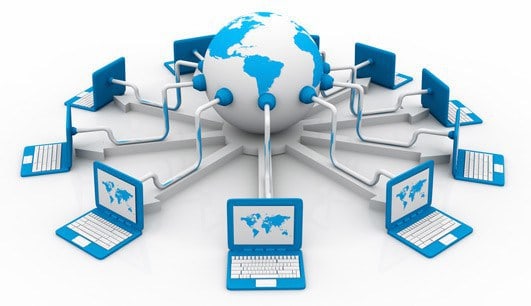Network security. What does this actually mean? Learn all about it
Today, we live in a world in which, the use of new technology is greatly enhancing the ability to communicate with each other. The Internet has been globalized very fast and relationships are continuously changing and evolving in all areas.
In this article we will discover what a network is and how we can manage our own network in an efficient way from the office or home. All about network security will be covered in the final part of this article, where we will discover how to improve network security. We will be going through complex concepts but don’t worry, whatever your previous knowledge, you’ll understand everything.

How would our lives be if we didn’t have Internet? If we didn’t have Facebook, YouTube, Netflix, our lives would be so different, I think we can all agree that, internet, that network that we all know, has improved the quality of our lives. But it is quite overwhelming to know that it has no limits. In the past, what we thought it was impossible, today it is a tool fully implemented on our daily basis and we use it very often.
The term human network is the interaction between the Internet, companies and everyday people. For example, the way of learning and training, has incredibly improved. Now we can do courses or careers, from home. In the past, it was impossible to access certain content due to the great amount of time that was needed, and this is something that nowadays companies take advantage from it, when it comes to training their employees.
Our leisure is strongly affected by the use of the network, and specially Videogames. Everything has changed; remember when you used to play “Monkey Island” alone in front of your computer, well now there are great network games such as “League of Legends” or “Call of Duty”.
One of the most common types of network communication is that of client-server, which we use in our daily lives. Well, this type of communication is carried out in tasks like when we double click on the icon of our web browsers, or when sending emails, or accessing web pages … In these cases, we are the client who requests information from the server, which could be, for example, the company that provides us the email service. In order to use the network and access these contents, we use software that allows us to request any information from the specific server, this is the web browser.

The most basic infrastructure of any network is usually composed of: devices, media and services. Media and devices are hardware elements of the network, for example a router or a PC. The services, as we mentioned earlier, can be any web hosting.
We are familiar with a certain network device that is called a terminal. This is just the destination and origin of any message transmitted through the network. In order to make a distinction between terminals, a specific address is used. This way, when communicating with one another, this address is indicated and this makes the message reach the destination that we want. To connect these terminals there are intermediary devices that for this task, the most common one is the router.
If we think about the physical mean that is used to carry out this communication, there are a few of them. These can go from the wires that are in the cables, to the fibre optic, the wireless connection of our Wi-Fi, etcetera… Every network interface is identified by a unique Mac address in the world, which makes them different from the rest when communicating. This address acts as an identity card.
We have to dig deeper into another term in order to understand the operation of a network, this term is called Gateway. Its main function is to work as a gateway between our local network (us) and the outside, translating protocols so that communication is possible. An IP address is assigned to a device, and from that moment on it will act as a gateway. At home, this is the router.
We will discover now the most common network types. We have LAN networks for a small area, the WAN network for an extensive geographic network, and for example the WLAN network, which is similar to the LAN, but wireless. It will depend on the number of users, the size of the area to be covered and the number of services that we will use.
Do you know who provides the connection to the network? Well, this is called ISP, these are the Internet service providers. The most common connection options are: cable, DSL (digital subscription), satellite or dial-up telephony.
A frequent concern of network users is network security. And they have the right to be concerned, since the sensitive information that we transmit by this means, from the data of our bank accounts, to multimedia files could be at risk.

The most common threats that are out there are viruses, worms, Trojans, spyware, adware, zero-hour attacks, identity theft, among others. Many studies have been carried out in order to check which are the best habits to make our network safer, and we have always found the same thing, the worst enemy in our network is our own finger. Let me show you, users have a common habit of pressing all kinds of links without thinking about whether that is safe or not. With a preventive attitude we would avoid 70% of the security problems in our network.
The typical network security components that we know are: antivirus and antispyware, firewall filtering, file encryption, and other mechanisms. All these should be activated on our PCs to avoid problems in the future. Most of them have free versions, so you can have a decent antivirus installed on your PC. If we want to buy an antivirus with all the features, there are cheap options and we can have up to 5 devices with a single annual payment.
In addition to the most usual ones, we also have tools to guarantee extra security. Some of them may be: access control lists (ACL), which filter access and forward traffic; virtual private networks (VPN), which offer safer access for example to remote workers; intrusion prevention systems (IPS), which monitors network traffic or system activity in search of malicious action and dedicated firewall systems, which offer more powerful firewall functionalities to filter traffic.
With this article we wanted to let you know about all kinds of interesting information related to the networks and the security of these. It’s good to know about this since we are constantly using them and sometimes we forget about safety.
Thank you very much for reading the articles that we’ve published in the blog, now that you have increased your knowledge in networks, you can go a step further and monitor them, you can go to the Pandora FMS website to discover an excellent tool for monitoring networks.
Pandora FMS’s editorial team is made up of a group of writers and IT professionals with one thing in common: their passion for computer system monitoring. Pandora FMS’s editorial team is made up of a group of writers and IT professionals with one thing in common: their passion for computer system monitoring.


















